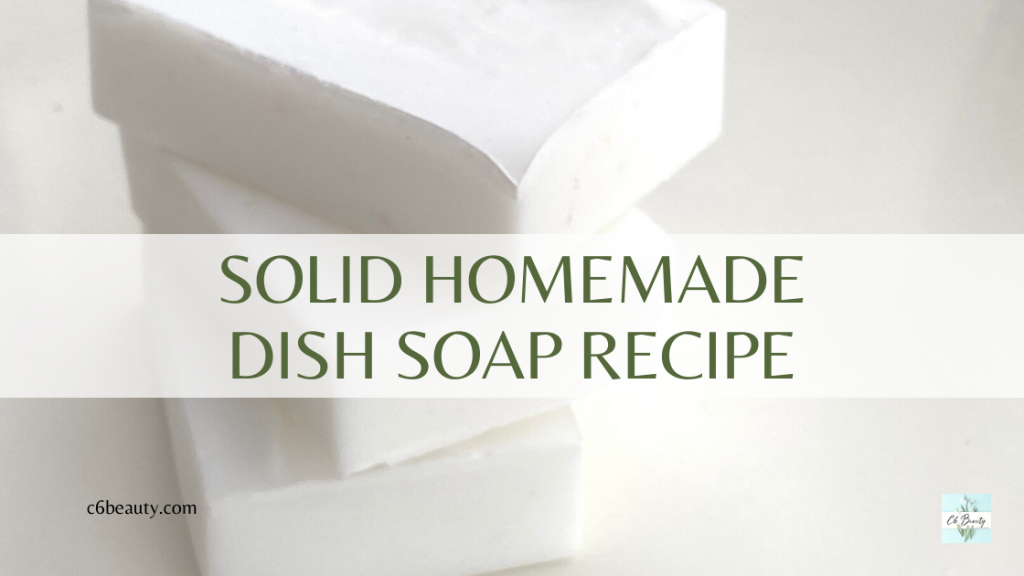One of the main reasons I decided to make my own products at home is to reduce the amount of plastic I use on a daily basis. I realized that most of the plastic I was throwing away was nothing more than empty containers of soap, shampoo, dishwashing liquid, or laundry detergent. Eliminating this plastic waste completely was what prompted me to create soaps at home. Among the soaps that I just can’t give up is solid coconut oil-based dish soap. Just to have this ally at home, it’s really worth it to start making soaps. In this post, I show you a recipe to make solid homemade dish soap using the cold process method.
Disclosure: Some of the links in this post are affiliate links. By clicking through them and making a purchase, I may receive a small commission WITHOUT any additional cost to you.
Gabi
But before..if you’re interested in creating homemade soaps, but don’t know where to start, check out the course I create! Everything you need to know about making soap using the cold process method.
Why is coconut oil used in soap making?
Coconut oil is very often used in cold process soap formulations, mainly because of its excellent cleaning properties. Coconut oil is often used in quantities not exceeding 20% to prevent the soap from becoming too aggressive for the skin. But the question is: “if it is preferable to use it in low % why are we going to create a soap bar with only coconut oil?”. We are doing it because we are creating a soap intended for washing dishes and kitchenware. These, in general, are greasy and very dirty and require a powerful cleaning soap. If like me, you don’t use plastic gloves to wash dishes, you may end up with slightly dry hands once finished but no big deal. A moisturizer will solve this slight annoyance.

What coconut oil is used for soap?
We can find coconut oil under different names. It can be virgin, refined, or fractionated depending on the production process from which it is obtained and the chemical characteristics it has. Personally, I’ve tried all types of coconut oil in my soaps and liked the results. In particular for dish soap, although in many forums I read that fractionated coconut oil should not be used, I honestly used it and did not find any strange behavior neither at the sight nor during use, maybe just the smell is not so pleasant. What we should pay attention to is to consider the right SAP (saponification value). If refined coconut oil has a SAP for NaOH equal to 0.183, fractionated coconut oil has a SAP(NaOH) equal to 0.232. An important detail to consider in order to avoid calculation errors.
How to make Solid Homemade Dish Soap: Video
How to make Solid Homemade Dish Soap | Recipe
To make solid dish soap we have to bring to zero the amount of free oils. Technically is defined as 0% of superfat that means that all fatty acids contained in the oil will react with the caustic soda to become soap. For this recipe, I used virgin coconut oil instead of refined one. I decided to use it to test its cleaning properties so I could use it in case I have trouble finding the refined one.
Solid Homemade Dish Soap: Ingredients and tools
The ingredients used are:
- 200g (7.05Oz) 100% virgin coconut oil (you can find a similar here)
- 36.6g (1.29Oz) caustic soda (you can find it here)
- 76g (2.7Oz) distilled water (you can find it here)
The main tools are:
- protective goggles (you can find them here)
- glass rod (you can find it here)
- protective gloves (find them here)
- protective mask (find it here)
- silicone molds (you can find them here)
- hand blender (you can find it here)
To make soaps in a completely safe way, I recommend reading my post on ‘what they don’t tell you about homemade soap‘. I felt it was really important to describe the mistakes I made in my first few months of soap making. This post will help you avoid potentially critical situations just by following some simple steps.
Solid Homemade Dish Soap: Directions
To make this soap I poured the coconut oil into a pyrex glass container.

After that, I prepared the caustic soda solution. I weighed the lye and poured it into the previously weighed water (NEVER THE CONTRARY! Always lye in the water!)
Further TIPS: To prepare the caustic soda solution, I prefer to use 50% of water and 50% of the remaining water as ice. Being a very energetic reaction, this trick allows me to control the temperature and prevent it from rising rapidly to 80°C.
When it is completely dissolved in water and its temperature is around 45C (113F) all that remains is to gently pour it into the container with the coconut oil and mix with a hand blender. When the mass is creamy and consistent and has reached the trace, we can pour it into the mold and let it cure for four weeks.

Considerations
To use it just wet it with a little water, rub it on a sponge (possibly reusable), or better on a dish brush and clean the dishes.

Share with me your creations, tag me @c6beauty, or leave me a comment. If you are interested in other recipes for soap production with the cold method here are some links:
- How to Make Mango Soap
- How to Make Soap with two colors
- Scrubby Homemade Soap with Coffee
- Oatmeal Soap Bar
Ready to make your first soap with my FREE guide to making soap?

If you like my content, help me with a small donation. With your support, I would like to buy new ingredients and create original healthy beauty products! Thank you 🙂
Gabi


